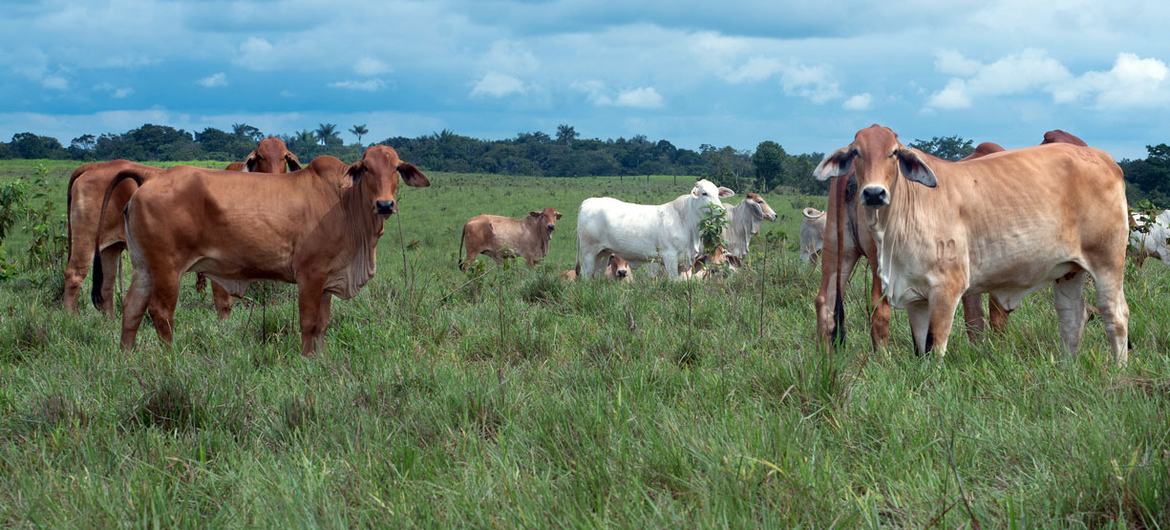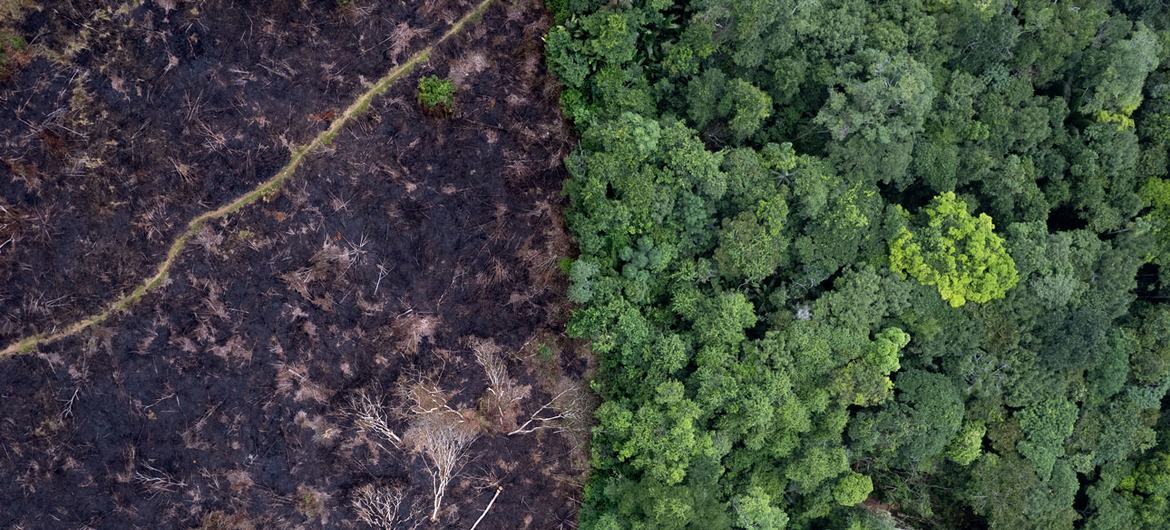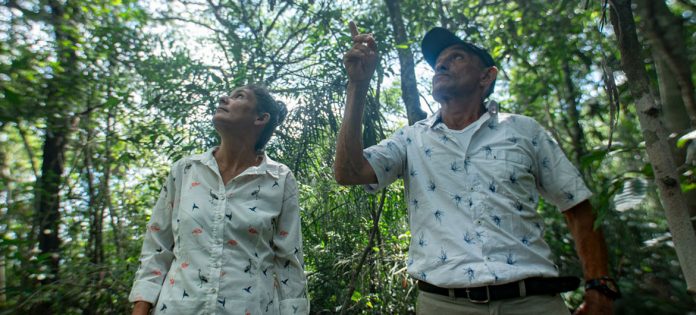This waterway, a silent witness to the turmoil of the municipality of Mapiripán, has seen it all – the wildlife trafficking, the coca harvests that fuelled conflict, the human bodies left behind amid a heinous massacre and the relentless erosion of the rainforest it once nourished.
Now, Sandra hopes it will carry away the pain of the past and usher in an era of healing for her community and for its land.
Mapiripán has long been trapped in a cycle of conflict and environmental degradation exacerbated by climate change. Many years ago, it was known for its illegal wildlife fur trade; later, it became a coca-growing region, attracting armed groups that turned the lush rainforest into a battleground.
Promise of prosperity
A young Sandra, facing extreme poverty and violence, arrived in Mapiripán in the early 2000s, drawn by a promise of prosperity. “There was an economic boom,” she recalls, “but it came from illicit crops – there was no other way to live.”
But the area’s prosperity was short-lived. Eventually, the conflict escalated, and the coca trade collapsed, leaving the community in ruins. “We lived with both prosperity and conflict,” Sandra says, her voice trembling as she recounts harrowing experiences of hiding from armed groups.
By 2009, most of the people in the rural communities in the region were forced to leave.
Many, including Sandra, returned after the signing of the Colombia Peace Agreement in 2016 which ended a decades-long rebel insurgency.
But the land, scarred by conflict and unsustainable cultivation, now struggled to produce. With a lack of infrastructure and limited market access, farmers like Marco Antonio Lopez turned to cattle ranching for survival.
Deforestation boom
This meant clearing more forests. “We would deforest 15 or 20 hectares with our own hands for our cattle,” he admits, “not to destroy biodiversity, but to find a way to survive.”
They also watched helplessly as newcomers took over abandoned areas and deforested even larger swaths of land. “They didn’t care about deforesting 700 to 1,000 hectares,” Sandra says with disgust. “They would just cut right through the centre of the mountain.”
The consequences were becoming all too clear: “That’s when we started to feel the heat, to notice the change in the climate,” she adds.

A silvopastoral system in the Amazon integrates trees and shrubs into livestock pastures. This increases carbon storage in trees and soil, reducing greenhouse gas emissions from livestock and fertilizer and boosting resilience to climate change.
Sandra and Marco now long for a future where they can improve their lives while protecting the forests, a desire shared across the country.
In fact, Colombia has made significant progress in curbing deforestation. The nation demonstrated that, between 2015 and 2016, deforestation rates in its Amazon Biome dropped substantially, preventing almost seven million tons of CO2 emissions.
This success helped the nation secure a $28.2 million Results-based Payment (RBP) from the Green Climate Fund (GCF) in 2020 to implement the Colombia REDD+ (Reducing Emissions from Deforestation and Forest Degradation) project, known in the country as Vision Amazonia.
Led by the UN’s Food and Agriculture Organization (FAO), Vision Amazonia promotes conservation and sustainable land management in rapid deforestation areas like Mapiripán.

A silvopastoral system in the Amazon integrates trees and shrubs into livestock pastures. This increases carbon storage in trees and soil, reducing greenhouse gas emissions from livestock and fertilizer and boosting resilience to climate change.
‘We, the community’
In coordination with the Colombian government and local communities, the FAO project which runs until the end of 2026, protects the Amazon biome through forest monitoring and sustainable management practices, benefitting smallholders, farmer associations and local authorities alike.
“We, the community, are already aware of the problem caused by climate change. Now when we go out into the field to do work, the sun is so strong that we cannot resist the heat anymore. We have truly begun to develop an awareness of the need for preservation of these beautiful ecosystems that we have in the territory,” says Marco.
“If the forest thrives and we thrive, the animals thrive,” Sandra adds.

Deforestation releases carbon into the atmosphere, which fuels climate change and further harms forests.
“With this project,” explains Sandra Vanegas, FAO local markets coordinator, “we are ensuring forest conservation while families generate resources through associative projects.
“We are promoting agroforestry gardens where they can produce for their own consumption and conserve seeds and endemic plants.”
Indeed, Marco and Sandra’s communities have now gained a deep understanding of agroforestry, a sustainable land use practice that combines agriculture and forestry. Through educational visits, they’ve witnessed firsthand how to revitalize their soils with organic fertilizer and grow their own food.
Marco recounts a gradual awakening regarding their livestock. “We didn’t know at the time,” he admits, “that we didn’t need a huge extension of pastures for our cows to have good nourishment.”
The initiative, he says, opened their eyes through a series of training sessions. Now they have started to implement silvopastoral systems by planting trees on their family farms.
“They gave us a broader perspective, helping us realize the damage and consequences of continued deforestation. That’s when we, as leaders, took a stronger stance to protect the forest.”
This newfound awareness led them to form the AGROCIARE association to pursue sustainable projects. For instance, they have been actively working to plant and commercialize the cacay tree, a native Amazonian species known for its nutritious fruit.
With training in legal and organizational skills, they’ve strengthened their association’s capacity to advocate for environmental protection and better livelihoods.
“Our vision is to ensure that the treasure of our environment and rainforest is protected by those of us who live here,” Marco declares.
By working with the rural communities, the programme is finding climate solutions that are effective, equitable and offer a different future for the Amazon.
Agrifood systems solutions are climate, biodiversity and land solutions
This story is part of a three-part series from FAO on climate, biodiversity and land solutions in Colombia. These stories take you from the arid landscapes of La Guajira, where the SCALA programme is supporting climate resilience and food security, to the Pacific coast, where a Global Environmental Facility-supported project is working to conserve rich biodiversity while also contributing to the pursuit of peace.

